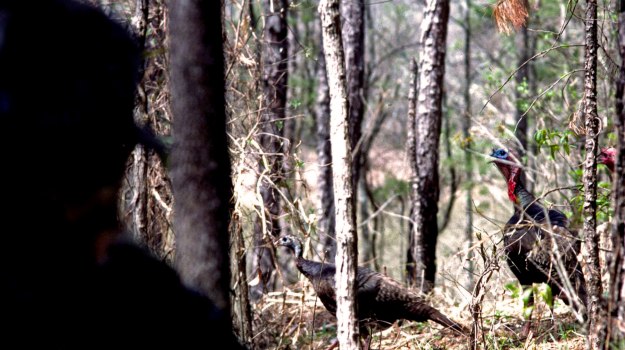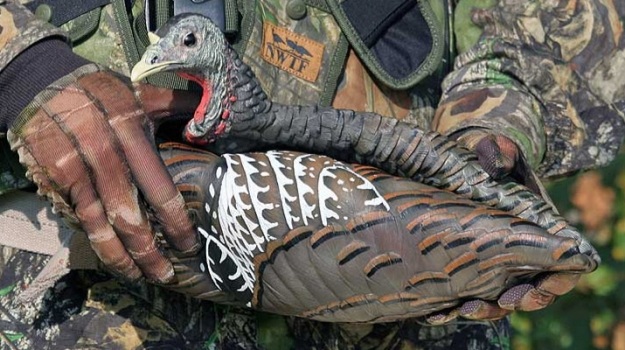
with John E. Phillips
Mossy Oak’s Eddie Salter Remembers the Bad Foot Gobbler
 Editor’s Note: Eddie Salter of Evergreen, Alabama, has hunted turkeys for almost 50 years, hosts “The Turkey Man” on the Pursuit Channel, and is a Pro Staffer for the Down-n-Dirty Outdoors call company. Eddie has won two World Turkey Calling Championships and too-many state, regional and local turkey-calling championships to remember. If you’ve ever been to one of the thousands of turkey-hunting and turkey-calling seminars where Salter has performed, you know he can call turkeys just as well with his natural voice as with any type of turkey-calling device. This week, we’ve asked Salter to tell Mossy Oak readers about some of the toughest turkeys he ever has tried to take.
Editor’s Note: Eddie Salter of Evergreen, Alabama, has hunted turkeys for almost 50 years, hosts “The Turkey Man” on the Pursuit Channel, and is a Pro Staffer for the Down-n-Dirty Outdoors call company. Eddie has won two World Turkey Calling Championships and too-many state, regional and local turkey-calling championships to remember. If you’ve ever been to one of the thousands of turkey-hunting and turkey-calling seminars where Salter has performed, you know he can call turkeys just as well with his natural voice as with any type of turkey-calling device. This week, we’ve asked Salter to tell Mossy Oak readers about some of the toughest turkeys he ever has tried to take.
I’ve learned my best turkey-hunting strategies from some of the baddest birds on the planet. The Bad Foot Gobbler lived on a 730-acre tract of land where I had permission to hunt. I had seen this bird and his tracks, while deer hunting in the fall, and I knew he was a big old gobbler. I was supposed to be the only one with the rights to hunt turkeys on this property. During the spring, the landowner had told me about seeing a flock of turkeys on the back side of her field. The first day I went to hunt this gobbler I checked the field first, but there were no turkeys. So, I moved off the field edge and got down in a hardwood bottom. I called, and heard a turkey gobble. I moved closer where I could see a big gobbler with a flock of hens. This bird was strutting, drumming and putting-on a show every turkey hunter dreams of seeing. The tom wasn’t gobbling very much, so I decided to fire him up with aggressive cutting and cackling. I needed the gobbler to come 30- to 40-yards closer to make the shot.
As I started cutting, cackling and calling aggressively, I watched the Bad Foot Gobbler come to full attention. From watching turkeys all my life, I know when a turkey pulls his wings in tightly to his body, he’s about to leave town. I call that wing-tucking, “Packing his suitcases,” and that’s exactly what this gobbler did. He walked straight-away from me and the hens followed him. In the spring, a gobbler usually follows the hens, but when this gobbler decided to leave town, his lady friends chased after him. When the birds were out of sight, I scratched my head and thought, “What’s happening with that crazy bunch of turkeys?” From that first encounter with the Bad Foot Gobbler, I knew he wasn’t really excited about breeding. The next morning, I hunted him again. I found the flock of turkeys and saw the Bad Foot Gobbler. Because I’m extremely confident in my calling ability, I decided to try and fire him up again with excited cuts and cackles. Immediately, that gobbler straightened-up, came to attention and walked away from me.
I hunted that turkey seven different days for about a month. I kept up with him by his tracks. The back toe on his right foot was bent under and deformed, causing him to limp, and I could follow his tracks in the mud. I’d stay away 4 or 5 days at a time and then go back to call him again. I messed with that bird so much, he wouldn’t even gobble to an owl call before daylight. Finally, the only way I could get that turkey to gobble and give-away his location was to gobble with a diaphragm mouth call. A good friend of mine, the late Ben Rodgers Lee from Coffeeville, Ala., the winner of about every turkey-calling contest anywhere, used to say, “When you’re dealing with an ole bad gobbler, if you call to him, you won’t kill him. If you want to harvest that bird, don’t call to him.”
Finally, on a Sunday morning, before church, I went to the property. I owl-hooted, but the woods were dead silent. I put my diaphragm mouth call in my mouth and gobbled to the bird. He gobbled one time, letting me know he was in the hardwood bottom. Instead of going straight to the turkey, I circled him to call from the other side. When I got in position, I gobbled to the turkey, and he gobbled back. However, when I tree-yelped to the turkey, he didn’t answer me. As soon as I gave that tree yelp, I took my diaphragm mouth call out of my mouth, put it in its case and pitched it about 10-yards away from me, so I couldn’t call to him again. I thought to myself, “You’ve used all your best calls on this gobbler, and he hasn’t liked any of them. Now you just need to sit here for a while and see what happens next.” About 15-minutes later, I heard a twig snap, and a bird came flying through the trees. The gobbler landed 28 steps from me. He took one step and limped to take a second step, before he kissed lead and fell over dead. I think this gobbler was about 7-years old, because he had 1-1/4-inch spurs that were broken off from fighting. His old legs were white, and he only weighed 14 pounds. I knew other hunters had been chasing this bird for years. This turkey taught me that to take a tough tom, you need to have more patience and do less calling. Remember, an old gobbler probably knows more about turkey hunters than turkey hunters know about turkeys.
Tomorrow: Eddie Salter Explains What Makes Southern Turkeys So Tough to Take






























